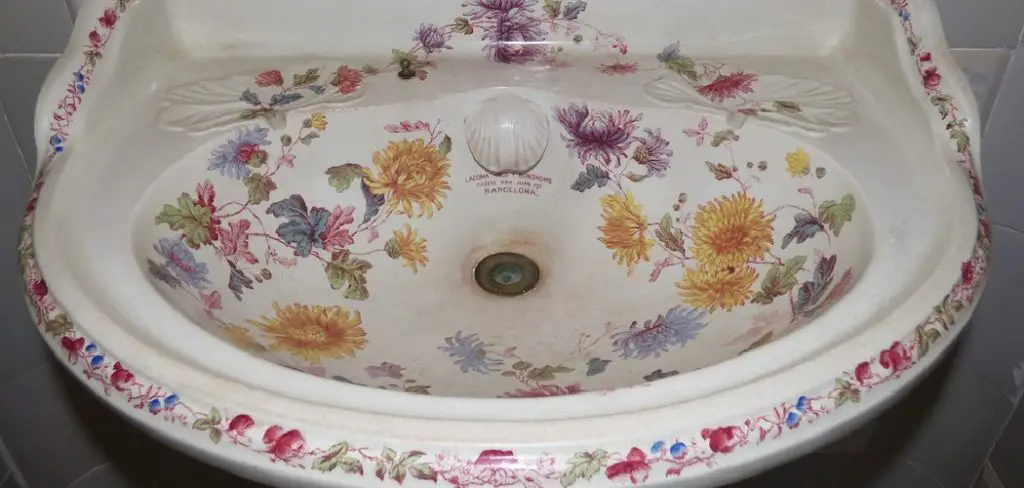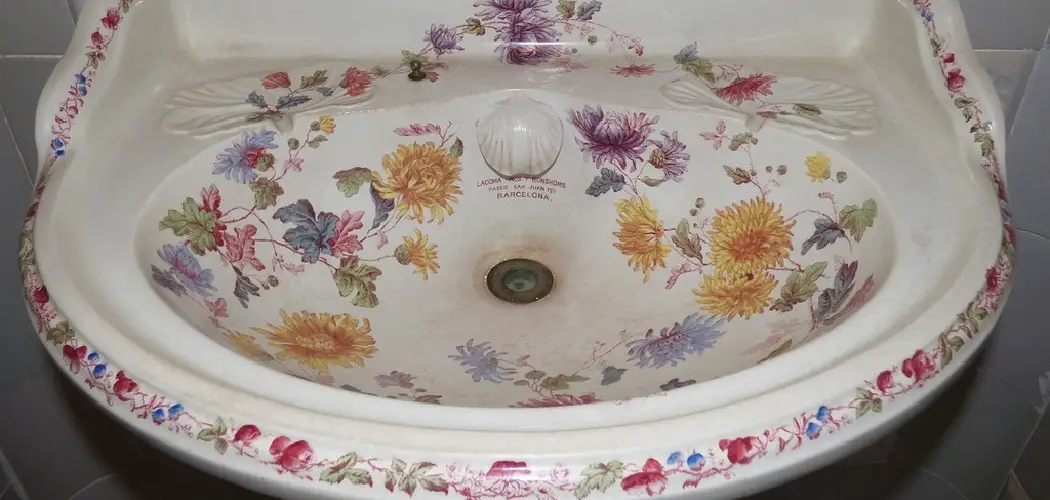To paint a porcelain sink, you must first sand the surface for better adhesion and then apply a high-quality porcelain sink paint in thin, even coats. A porcelain sink can bring a vintage charm to your bathroom or kitchen, but over time, it may begin to look dull or discolored.
Replacing a sink can be expensive, but with a few simple tools and a porcelain sink paint kit, you can transform it into a like-new condition. However, it is essential to follow the proper technique to ensure that the sink will have a long-lasting, smooth and durable finish.
In this article, we will guide you through the process of painting a porcelain sink, providing you with all the necessary steps and tips for a successful project.

Revitalize Your Bathroom: How To Paint A Porcelain Sink
Is your porcelain sink looking dull and stained? Is replacing it out of your budget? Why not consider painting it? Painting a porcelain sink can be an easy and cost-effective way to rejuvenate your bathroom without breaking the bank. This article will provide a brief overview of the objective of painting a porcelain sink and highlight the advantages of this method over replacing the entire sink.
Advantages Of Painting A Porcelain Sink
When it comes to revitalizing a porcelain sink, painting it can offer numerous advantages over replacing it altogether.
Here are some of the benefits of painting your porcelain sink:
- Cost-effective: Repainting your sink is considerably more affordable than a full replacement, especially when you have a tight budget.
- Time-saving: Replacing a sink is a time-consuming process, including removing and installing it. Painting, on the other hand, is a quicker and more straightforward solution.
- Customization is possible: Painting your sink provides you with the opportunity to choose a different color or pattern, giving it a brand-new look.
- Eco-friendly: Reusing the same sink instead of replacing it can reduce environmental waste and make your footprint lighter.
- Increases sink longevity: A quality paint job can help prevent further wear and tear on your sink, giving it a fresh appearance and making it last longer.
Materials Needed To Paint A Porcelain Sink
Before starting the painting process, it is essential to gather all the necessary materials. Here’s what you will need:
- Sandpaper (fine grit)
- Tsp cleaner
- Paintbrush and rollers
- Porcelain bonding primer
- Porcelain paint
- Clear coat protective finish
Steps To Painting A Porcelain Sink
The actual painting process can be broken down into six simple steps:
- Clean the sink: Use tsp cleaner to scrub your sink thoroughly and remove any debris or stains.
- Sand the sink: Use fine grit sandpaper to roughen up the shiny surface slightly. This will help the primer stick to the surface better.
- Prime the sink: Begin by applying a coating of porcelain bonding primer. Let it dry for a few hours or as suggested by the manufacturer.
- Paint the sink: Once dried, paint the sink with porcelain paint using a paintbrush or roller.
- Add another layer: Wait for the first coat to dry, before repeating the process to provide your sink with a second layer of paint.
- Seal the sink: Once the second coat dries, apply a protective clear coat to ensure the paint remains durable for the long term.
Painting your porcelain sink can be a budget-friendly and eco-friendly way to revitalize your bathroom. By following these simple steps and using quality materials, you can achieve a stunning finish on your sink that will make it look brand new.
Give it a try and see the magic!
Preparing For The Project
Evaluate The Current Condition Of The Porcelain Sink.
Before painting a porcelain sink, it’s essential to examine its current condition properly. Here are some key points that one should consider while evaluating the sink’s condition:
- Check for any cracks or chips in the sink.
- Determine if the porcelain is stained and discolored or if it has lost its shine or finish.
- Make sure the surface is clean and free from any dirt, oil, or grime.
Gather The Necessary Tools And Materials.
To paint a porcelain sink, you’ll need to have the right tools and materials. Here are the key items you’ll need:
- Gloves, protective eyewear, and a respirator mask.
- Powerful cleansing agents such as ammonia or a degreaser to clean the sink.
- Sandpaper, scrub pads, and a wire brush to smoothen the surface.
- Painter’s tape and plastic sheets to cover surrounding areas.
- Epoxy cleaner and primer to create a robust and long-lasting bond with the porcelain surface.
- Porcelain paint and brushes for applying the paint.
Select Appropriate Paint And Color Options.
Choosing the right paint and color is crucial to achieving the desired look of your porcelain sink. Here are some tips to help you make the right selection:
- Porcelain paints come in different colors such as black, ivory, and white. To get the best results, choose a color that matches the rest of your bathroom fixtures.
- Select a paint formula that provides excellent adhesion and durability on porcelain surfaces to prevent chipping and fading.
- Consider using a gloss or high-gloss sheen to create a shiny finish that’s easy to clean and maintain.
By following these aforementioned tips, you can prepare your porcelain sink for painting, select the necessary tools and materials, and choose the appropriate paint and color options to transform your sink and enhance the overall appearance of your bathroom.
Cleaning And Prepping The Sink
Painting a porcelain sink is an excellent way to rejuvenate your old, worn-out sink and give it a fresh new look. Before you begin painting, it’s crucial to clean and prep the sink properly to ensure that the paint adheres correctly and lasts a long time.
In this section of the blog post, we’ll discuss the essential steps on how to clean and prep a porcelain sink.
Instructions For How To Clean A Porcelain Sink, Including Recommended Cleaning Products.
Cleaning your porcelain sink is an essential first step in preparing it for painting. Here are some instructions on how to clean your sink:
- Use mild dishwashing soap and water to clean the sink.
- Choose cleaners that are non-abrasive to avoid scratching the surface.
- Avoid using cleaners that contain bleach or ammonia, as they can damage the sink’s surface.
Step-By-Step Process For Preparing The Sink For Painting, Such As Sanding And Surface Cleaning.
After you’ve cleaned the sink, you need to prep it for painting. Follow these simple steps to prepare the sink:
- Sand the surface of the sink with fine-grit sandpaper to create a rough surface for the paint to adhere to.
- Clean the sink thoroughly with a mild detergent to remove any leftover residue or debris.
- Rinse the sink with water and dry it completely with a clean cloth.
- Apply a bonding primer to the sink, which will help the paint adhere better and prevent it from chipping or peeling off.
By following these simple instructions, you can clean and prep your porcelain sink to perfection, ready for painting. Remember, proper cleaning and preparation are crucial for the success and longevity of the project, so take your time with this step to achieve the best results.
Painting The Porcelain Sink
If you’re looking for a cost-effective way to update your porcelain sink, painting it might be the perfect solution. With the right supplies and techniques, you can have a smooth finish that will last for years. Here are some detailed instructions for painting a porcelain sink, including techniques and recommendations for a smooth finish.
Detailed Instructions For Painting A Porcelain Sink, Including Techniques And Recommendations For A Smooth Finish:
- Clean and dry your sink thoroughly to remove any dirt or grime.
- Sand the surface of the sink with a fine-grit sandpaper to create a rough surface that the primer can adhere to.
- Apply a high-quality bonding primer to the surface and let it dry completely. This will ensure that your paint will stick to the sink and give you a long-lasting finish.
- Once your primer is dry, you can begin painting your sink with a ceramic or porcelain paint. Apply two to three thin coats of paint, allowing each coat to dry completely before applying the next one. This will prevent bubbles, peeling, or brush strokes from ruining your sink’s finish.
- Once your final coat of paint is dry, you can apply a clear sealant to protect your sink from damage or scratches.
How To Apply Multiple Coats Of Paint For Optimum Coverage And Durability:
- Make sure to use a ceramic or porcelain paint to ensure durability and longevity.
- Apply two to three thin coats of paint instead of one thick coat. This will prevent bubbles, peeling, or brush strokes from ruining your sink’s finish.
- Allow each coat of paint to dry completely before applying the next one.
Tips For Avoiding Common Pitfalls Such As Bubbles, Peeling, And Brush Strokes:
- Make sure your sink is clean and dry before starting the painting process.
- Sand the surface of the sink with a fine-grit sandpaper to create a rough surface that the primer can adhere to.
- Use a high-quality bonding primer to help the paint stick to the sink.
- Apply paint in thin layers, allowing each coat to dry completely before applying the next one.
- Use a brush with soft bristles to avoid leaving brush strokes on your sink’s surface.
- Be patient – rushing the process can result in bubbles, peeling, or a poor finish.
Follow these steps, and you’ll have a beautifully painted porcelain sink that looks brand new.
Curing And Maintaining Your Porcelain Sink
Painting a porcelain sink can be a fun diy project that can give your sink a refreshing and updated look. However, after completing the painting process, it is crucial to follow several guidelines for curing and maintaining your porcelain sink.
Guidelines For How Long To Wait Until Using The Sink After Painting
After you have painted your porcelain sink, it is crucial to allow the paint to cure completely before using the sink again. Here are some guidelines to follow:
- Wait for at least 24 hours before using the sink.
- Avoid placing any heavy objects or harsh chemicals on the sink for at least 48 hours.
- It’s necessary to let the paint cure completely before exposing it to water and all other substances.
Tips For Maintaining The Sink’S Appearance And Longevity
To maintain the appearance and longevity of your porcelain sink, it’s essential to follow these tips:
- Avoid using abrasive cleaners that can damage the painted surface of the sink. Instead, use mild cleaners like dish soap or white vinegar. Be sure to rinse the sink thoroughly after each use.
- It’s necessary to clean any spills or stains as soon as they occur, as leaving them on the surface can cause discoloration and damage to the paint.
- Pay particular attention to the areas of the sink that retain moisture, such as the drain area, and ensure they get regular cleaning.
- Regular touch-ups are crucial to prolong the lifespan of your painted sink.
- Lastly, avoid using bleach or abrasive cleaning pads on the surface, as they can cause damage or discoloration to the painted surface of your sink.
Maintaining your porcelain sink may seem like a daunting task, but these simple steps can help prolong its lifespan and keep it looking great for years to come. Remember, regular maintenance is essential to ensuring that your painted sink maintains its appearance and longevity.
Frequently Asked Questions For How To Paint A Porcelain Sink
How Do You Prepare A Porcelain Sink For Painting?
Clean the sink thoroughly, sand it with a fine-grit sandpaper, and clean it again with a degreaser to remove any remaining oils or dirt.
What Kind Of Paint Can Be Used On Porcelain?
Epoxy resin-based paint or two-part epoxy paint is recommended for painting porcelain sinks as they can withstand harsh cleaning chemicals and water.
Do You Need To Prime A Porcelain Sink Before Painting?
Yes, it is important to use a bonding primer before painting the porcelain sink. It helps the paint adhere better and last longer.
How Many Coats Of Paint Are Required For A Porcelain Sink?
At least two coats of paint are required to cover the sink adequately. Wait a minimum of 24 hours before applying the second coat.
How Do You Maintain A Painted Porcelain Sink?
Regular cleaning of the painted porcelain sink with a mild cleaner is necessary to avoid damage to the paint. Avoid abrasive chemicals and sponges while cleaning.
Conclusion
Finally, painting a porcelain sink is a budget-friendly and easy way to update the look of your bathroom or kitchen. With the proper preparation and materials, and following the step-by-step instructions provided, you can achieve a beautiful and long-lasting finish.
Remember to choose a high-quality paint, use the proper tools, and allow enough drying time in between coats. Additionally, it is important to avoid abrasive cleaners and rough materials that can scratch the surface. By following these tips, you can enjoy your newly painted porcelain sink for years to come.
So go ahead and try your hand at this fun diy project – you may just surprise yourself with the impressive results you can achieve!

